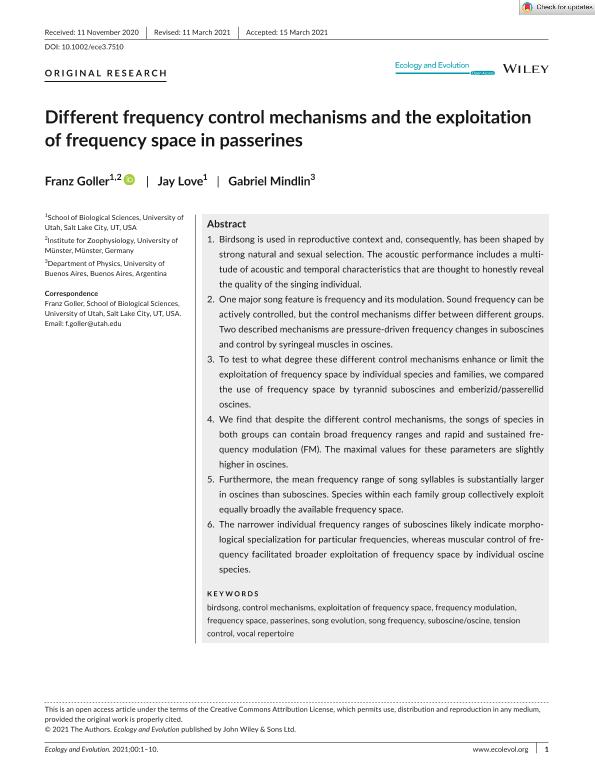Artículo
Different frequency control mechanisms and the exploitation of frequency space in passerines
Fecha de publicación:
03/2021
Editorial:
John Wiley & Sons Ltd
Revista:
Ecology and Evolution
ISSN:
2045-7758
Idioma:
Inglés
Tipo de recurso:
Artículo publicado
Clasificación temática:
Resumen
Birdsong is used in reproductive context and, consequently, has been shaped by strong natural and sexual selection. The acoustic performance includes a multitude of acoustic and temporal characteristics that are thought to honestly reveal the quality of the singing individual. One major song feature is frequency and its modulation. Sound frequency can be actively controlled, but the control mechanisms differ between different groups. Two described mechanisms are pressure-driven frequency changes in suboscines and control by syringeal muscles in oscines. To test to what degree these different control mechanisms enhance or limit the exploitation of frequency space by individual species and families, we compared the use of frequency space by tyrannid suboscines and emberizid/passerellid oscines. We find that despite the different control mechanisms, the songs of species in both groups can contain broad frequency ranges and rapid and sustained frequency modulation (FM). The maximal values for these parameters are slightly higher in oscines. Furthermore, the mean frequency range of song syllables is substantially larger in oscines than suboscines. Species within each family group collectively exploit equally broadly the available frequency space. The narrower individual frequency ranges of suboscines likely indicate morphological specialization for particular frequencies, whereas muscular control of frequency facilitated broader exploitation of frequency space by individual oscine species.
Archivos asociados
Licencia
Identificadores
Colecciones
Articulos(IFIBA)
Articulos de INST.DE FISICA DE BUENOS AIRES
Articulos de INST.DE FISICA DE BUENOS AIRES
Citación
Goller, Franz; Love, Jay; Mindlin, Bernardo Gabriel; Different frequency control mechanisms and the exploitation of frequency space in passerines; John Wiley & Sons Ltd; Ecology and Evolution; 11; 11; 3-2021; 6569-6578
Compartir
Altmétricas
Items relacionados
Mostrando titulos relacionados por título, autor y tema.
-
Colominas, Marcelo Alejandro ; Kuppel, Sylvain ; Pham, Duong-Hung (Institute of Electrical and Electronics Engineers, 2019-03)
-
Dellavale Clara, Hector Damian ; Urdapilleta, Eugenio ; Cámpora, Nuria Elide ; Velarde, Osvaldo Matias ; Kochen, Sara Silvia ; Mato, German (Society for Neuroscience, 2018)
-
Ferroni, Marina Valeria (Pontificia Universidad Católica del Perú, 2020-01)




